List of beys of Tunis
The beys of Tunis were the monarchs of Tunisia from 1705, when the Husainid dynasty acceded to the throne, until 1957, when monarchy was abolished.
| Bey of Tunisia | |
|---|---|
Provincial/State | |
 Flag of bey of Tunis | |
 Muhammad VIII al-Amin | |
| Details | |
| First monarch | Al-Husayn I ibn Ali |
| Last monarch | Muhammad VIII al-Amin |
| Formation | 15 July 1705 |
| Abolition | 20 March 1956 |
| Residence | Palace of Bardo |
| Pretender(s) | Prince Muhammad Bey |
History

The Husainid dynasty, originally of Cretan Turkish origin, came to power under Al-Husayn I ibn Ali on July 15, 1705, replacing the Muradid dynasty. For most of their rule, the Husainids ruled with the title of Bey. The Husainids ruled the Beylik of Tunis under the suzerainty of the Ottoman Empire until May 12, 1881, when Muhammad III as-Sadiq signed the Treaty of Bardo and the Beylik of Tunis came under the control of France as a protectorate. Following independence from France on March 20, 1956, the Kingdom of Tunisia was proclaimed and the Bey Muhammad VIII al-Amin assumed the title of King. He reigned as such until the Prime Minister Habib Bourguiba deposed the Husainid dynasty and declared Tunisia a republic on July 25, 1957.
Beys of Tunis (1705–1956)
| Name | Lifespan | Reign start | Reign end | Notes | Family | Image |
|---|---|---|---|---|---|---|
| Al-Husayn I ibn Ali الحسين الأول بن علي التركي | 1669 – 13 March 1740 (aged 71) | 15 July 1705 | 7 September 1735 (deposed) | Husainid |  | |
| Abu l-Hasan Ali I أبو الحسن علي الأول | 30 June 1688 – 22 September 1756 (aged 68) | 7 September 1735 | 22 September 1756 | Nephew of Al-Husayn I ibn Ali at-Turki | Husainid |  |
| Muhammad I ar-Rashid محمد الأول الرشيد | 1710 – 12 February 1759 (aged 49) | 22 September 1756 | 12 February 1759 | Son of Al-Husayn I ibn Ali at-Turki | Husainid |  |
| Ali II ibn Hussein علي الثاني بن حسين | 24 November 1712 – 26 May 1782 (aged 69) | 12 February 1759 | 26 May 1782 | Son of Al-Husayn I ibn Ali at-Turki | Husainid |  |
| Hammuda ibn Ali حمودة بن علي | 9 December 1759 – 15 September 1814 (aged 54) | 26 May 1782 | 15 September 1814 | Son of Ali II ibn Hussein | Husainid |  |
| Uthman ibn Ali عثمان بن علي | 27 May 1763 – 20 December 1814 (aged 51) | 15 September 1814 | 20 December 1814 (murdered) | Son of Ali II ibn Hussein | Husainid |  |
| Mahmud ibn Muhammad محمود بن محمد | 10 July 1757 – 28 March 1824 (aged 66) | 20 December 1814 | 28 March 1824 | Son of Muhammad I ar-Rashid | Husainid |  |
| Al-Husayn II ibn Mahmud الحسين الثاني بن محمود | 5 March 1784 – 20 May 1835 (aged 51) | 28 March 1824 | 20 May 1835 | Son of Mahmud ibn Muhammad | Husainid |  |
| Mustafa ibn Mahmud مصطفى بن محمود | 1786 – 10 October 1837 (aged 51) | 20 May 1835 | 10 October 1837 | Son of Mahmud ibn Muhammad | Husainid |  |
| Ahmad I ibn Mustafa أحمد الأول بن مصطفى | 2 December 1806 – 30 May 1855 (aged 48) | 10 October 1837 | 30 May 1855 | Son of Mustafa ibn Mahmud | Husainid |  |
| Muhammad II ibn al-Husayn محمد الثاني بن الحسين | 18 September 1811 – 22 September 1859 (aged 48) | 30 May 1855 | 22 September 1859 | Son of Al-Husayn II ibn Mahmud | Husainid |  |
| Muhammad III as-Sadiq محمد الثالث الصادق | 7 February 1813 – 27 October 1882 (aged 69) | 22 September 1859 | 27 October 1882 | Son of Al-Husayn II ibn Mahmud | Husainid | 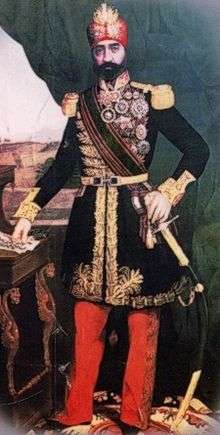 |
| Ali III ibn al-Husayn علي الثالث بن الحسين | 14 August 1817 – 11 June 1902 (aged 84) | 28 October 1882 | 11 June 1902 | Son of Al-Husayn II ibn Mahmud | Husainid | 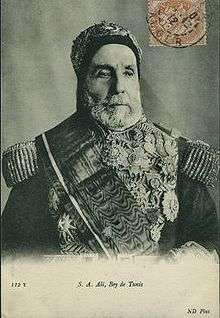 |
| Muhammad IV al-Hadi محمد الرابع الهادي | 24 June 1855 – 11 May 1906 (aged 50) | 11 June 1902 | 11 May 1906 | Son of Ali III ibn al-Husayn | Husainid |  |
| Muhammad V an-Nasir محمد الخامس الناصر | 14 July 1855 – 10 July 1922 (aged 66) | 11 May 1906 | 10 July 1922 | Son of Muhammad II ibn al-Husayn | Husainid | 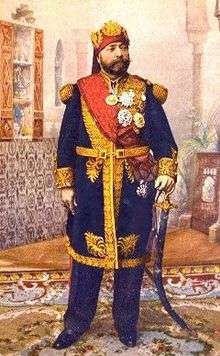 |
| Muhammad VI al-Habib محمد السادس الحبيب | 13 August 1858 – 11 February 1929 (aged 70) | 10 July 1922 | 11 February 1929 | Cousin of Muhammad V an-Nasir | Husainid | 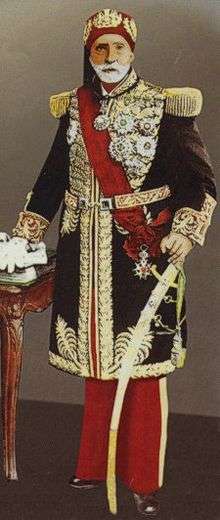 |
| Ahmad II ibn Ali أحمد الثاني بن علي | 13 April 1862 – 19 June 1942 (aged 80) | 11 February 1929 | 19 June 1942 | Son of Ali III ibn al-Husayn | Husainid | 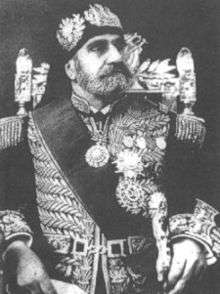 |
| Muhammad VII al-Munsif محمد السابع المنصف | 4 March 1881 – 1 September 1948 (aged 67) | 19 June 1942 | 15 May 1943 (deposed) | Son of Muhammad V an-Nasir | Husainid | 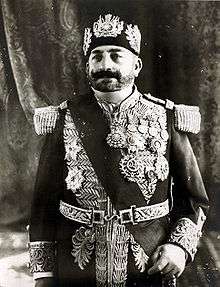 |
| Muhammad VIII al-Amin محمد الثامن الأمين | 4 September 1881 – 30 September 1962 (aged 81) | 15 May 1943 | 20 March 1956 (proclaimed King of Tunisia) | Son of Muhammad VI al-Habib | Husainid |  |
King of Tunisia (1956–1957)
| Name | Lifespan | Reign start | Reign end | Notes | Family | Image |
|---|---|---|---|---|---|---|
| Muhammad VIII al-Amin محمد الثامن الأمين | 4 September 1881 – 30 September 1962 (aged 81) | 20 March 1956 | 25 July 1957 (deposed) | Son of Muhammad VI al-Habib | Husainid |  |
Genealogical tree
Simplified genealogical tree of the Beys of Tunis. Only the Beys and their direct ancestors are shown.
| Ali at-Turki | |||||||||||||||||||||||||||||
| Muhammad | Husayn I r. 1705–1735 | ||||||||||||||||||||||||||||
| Ali I r. 1735–1756 | Muhammad I ar-Rashid r. 1756–1759 | Ali II r. 1759–1782 | |||||||||||||||||||||||||||
| Hammuda r. 1782–1814 | Uthman r. 1814 | ||||||||||||||||||||||||||||
| Mahmud r. 1814–1824 | |||||||||||||||||||||||||||||
| Husayn II r. 1824–1835 | Mustafa r. 1835–1837 | ||||||||||||||||||||||||||||
| Ahmad I r. 1837–1855 | |||||||||||||||||||||||||||||
| Muhammad II r. 1855–1859 | Muhammad III as-Sadiq r. 1859–1882 | Ali III r. 1882–1902 | Muhammad al-Ma'mun | ||||||||||||||||||||||||||
| Muhammad IV al-Hadi r. 1902–1906 | |||||||||||||||||||||||||||||
| Muhammad V an-Nasir r. 1906–1922 | Muhammad VI al-Habib r. 1922–1929 | ||||||||||||||||||||||||||||
| Ahmad II r. 1929–1942 | |||||||||||||||||||||||||||||
| Muhammad VII al-Munsif r. 1942–1943 | Muhammad VIII al-Amin r. 1943–1957 | ||||||||||||||||||||||||||||
Residence

Each bey has his palace because, according to tradition, he can not live in the palace of his predecessor for respect for his widows. Among the most important are those of Bardo, Ksar Said, Carthage, Hammam-Lif, Mornag or La Goulette. About the Bardo Palace, the French botanist René Louiche Desfontaines who visited the regency of Tunis at the end of the eighteenth century, left the following description:
"The bey lives in a pretty castle called Bardo, located in the middle of a large plain, three quarters of the north of the city. This castle is very old: Leo Africanus confirms that, in his time, kings have already make their stay. The wall that surrounds it is well built, and defended by some pieces of cannon placed on the side of the door. The court of the bey is numerous; the officers who compose it are, in general, very honest and very polite towards foreigners. "
Many have been converted after the abolition of the monarchy: the Bardo Palace hosts the Bardo National Museum (Tunis) and the Assembly of the Representatives of the People while the Carthage Palace became the headquarters of the Tunisian Academy of Sciences, Letters, and Arts.
- Some royal palaces
 View of the Bardo Palace around 1900
View of the Bardo Palace around 1900 Throne room of the Bardo Palace in 1899
Throne room of the Bardo Palace in 1899 Hall of Justice of the Bardo Palace in 1899
Hall of Justice of the Bardo Palace in 1899 Bey bedroom at Ksar Said Palace in 1899
Bey bedroom at Ksar Said Palace in 1899 View of a Ksar Said Palace salon in 1899
View of a Ksar Said Palace salon in 1899 Patio of the Rose Palace (present national military museum)
Patio of the Rose Palace (present national military museum)- Hall of Honor of the Rose Palace
Popular Culture
The colors of the Bey of Tunis, the red and the green which are components of the country's coat of arms. They are also those of the football club of the Stade Tunisien which was under his patronage.
They are also found in Tunisian pastries: one, called Bey sigh, is made of pink, green and white marzipan; the other, called bey's baklawa, is a form of Tunisian baklava.
Queen consort of Tunisia
The queen consort of Tunisia (Spouse of Bey of Tunis) is called Lalla Beya in reference to her husband.
She had little or no role in state affairs and didn't accompany her husband on diplomatic visits abroad or at official dinners at the palace. Her only concern was the management of the palace and the harem.
The first queen consort of the Husainid dynasty was Lalla Jannat, as wife of Al-Husayn I ibn Ali. Most beys have multiple spouses because polygamy was in use until the adoption of the Code of Personal Status in Tunisia. Very few have taken a single spouse, like Muhammad VIII al-Amin, who married only Lalla Jeneïna Beya (1887–1960) in 1902. She was the last queen consort of Tunisia before the establishment of the republic on 25 July 1957.
Queen Lalla Kmar (1862–1942) was queen consort of Tunisia during three reigns, after having successively married Muhammad III as-Sadiq, Ali III ibn al-Husayn and Muhammad V an-Nasir, and played a notable role in the affairs of the Beylik of Tunis. Muhammad V an-Nasir published a decree ordering the protection of Lalla Kmar, the absence of infringement of her rights and granting her a salary. He also built the Essaâda palace in La Marsa for her honor during the First World War, between 1914 and 1915.
See also
- Tunisia
- List of French residents-general in Tunisia
- President of Tunisia
- List of Presidents of Tunisia
- First Lady of Tunisia
- Head of Government of Tunisia
- Lists of office-holders
- List of current heads of state and government